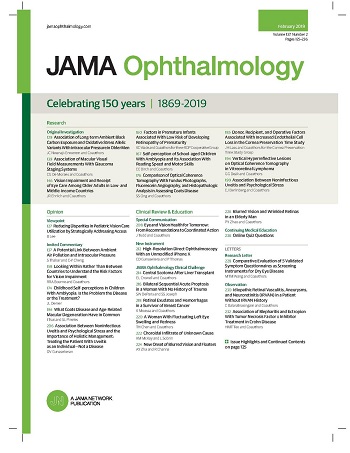Glucagon-Like Peptide-1 Receptor Agonists and Age-Related Macular Degeneration.
IF 9.2
1区 医学
Q1 OPHTHALMOLOGY
引用次数: 0
Abstract
Importance Glucagon-like peptide-1 receptor agonists (GLP-1RAs) are increasingly used for weight loss, but their ocular effects in nondiabetic individuals remain unclear. Prior studies suggest GLP-1RA use reduced age-related macular degeneration (AMD) risk in patients with diabetes, but applicability to nondiabetic populations is unknown. Objective To evaluate the risk of developing nonexudative AMD and its progression to exudative AMD among patients with obesity but not diabetes prescribed GLP-1RAs compared with those prescribed other weight-loss drugs (OWLDs). Design, Setting, and Participants This retrospective cohort study used electronic health record data obtained from the multicenter TriNetX Global Collaborative Network on patients aged 55 years or older diagnosed with overweight or obesity but not diabetes from January 2004 to July 2025. For the primary analysis, patients with preexisting nonexudative AMD were excluded. For the secondary analysis, patients with preexisting nonexudative AMD were included, while those with preexisting exudative AMD were excluded. Propensity score matching balanced baseline demographics and comorbidities. Data were analyzed on March 21, 2025, and August 2, 2025. Exposures Patients were prescribed either the GLP-1RAs liraglutide or semaglutide or OWLDs including lorcaserin, sibutramine, setmelanotide, fenfluramine, mazindol, orlistat, phentermine, and diethylpropion. Main Outcomes and Measures The primary outcome was development of nonexudative AMD at 5, 7, and 10 years. The secondary outcome was progression to exudative AMD at 10 years. Risk ratios (RRs) with 95% CIs were calculated. Standardized mean differences were used to assess covariate balance after matching. Results A total of 91 408 patients were included. After propensity score matching for the primary analysis, 45 704 patients remained in each of the GLP-1RA and OWLD cohorts. The GLP-1RA cohort included 35 753 (78.2%) females and 7852 (17.2%) males with a mean (SD) age of 61.1 (5.76) years, while the OWLD cohort included 35 732 (78.2%) females and 7815 (17.1%) males with a mean [SD] age of 61.0 (5.86) years. Covariate balance was achieved across all variables for the GLP-1RA and OWLD cohorts in the primary analysis. GLP-1RA use was associated with reduced risk of nonexudative AMD compared with OWLDs at 5 years (RR, 0.16; 95% CI, 0.10-0.28; P < .001), 7 years (RR, 0.13; 95% CI, 0.08-0.22; P < .001), and 10 years (RR, 0.09; 95% CI, 0.05-0.16; P < .001). No differences were observed in progression to exudative AMD. Conclusions and Relevance In this cohort study, GLP-1RA use was associated with reduced risk of developing nonexudative AMD but was not associated with progression to exudative AMD among individuals with nonexudative AMD. These findings may inform future randomized trials evaluating the ocular effects of GLP-1RAs in nondiabetic populations.胰高血糖素样肽-1受体激动剂与老年性黄斑变性。
胰高血糖素样肽-1受体激动剂(GLP-1RAs)越来越多地用于减肥,但其对非糖尿病患者的眼部影响尚不清楚。先前的研究表明,GLP-1RA可降低糖尿病患者的年龄相关性黄斑变性(AMD)风险,但对非糖尿病人群的适用性尚不清楚。目的评价肥胖非糖尿病患者服用GLP-1RAs与服用其他减肥药(owld)患者发生非渗出性AMD的风险及其向渗出性AMD的进展。设计、环境和参与者本回顾性队列研究使用从多中心TriNetX全球协作网络获得的电子健康记录数据,研究对象为2004年1月至2025年7月诊断为超重或肥胖但非糖尿病的55岁及以上患者。在初步分析中,排除了先前存在的非渗出性AMD患者。对于二次分析,纳入了既往存在的非渗出性AMD患者,而排除了既往存在的渗出性AMD患者。倾向评分匹配平衡基线人口统计学和合并症。数据分析时间为2025年3月21日和2025年8月2日。给患者开GLP-1RAs利拉鲁肽或半马鲁肽或OWLDs,包括氯卡司林、西布曲明、塞美拉肽、芬氟拉明、马辛多尔、奥利司他、芬特明和丙二醇。主要结局和测量:主要结局是在5年、7年和10年发生非渗出性AMD。次要结果是在10年时进展为渗出性AMD。计算95% ci的风险比(rr)。标准化平均差异用于评估匹配后的协变量平衡。结果共纳入91例 408例患者。在初始分析的倾向评分匹配后,每个GLP-1RA和OWLD队列中仍有45 704例患者。GLP-1RA队列包括35名 753(78.2%)女性和7852(17.2%)男性,平均(SD)年龄为61.1(5.76)岁;OWLD队列包括35名 732(78.2%)女性和7815(17.1%)男性,平均[SD]年龄为61.0(5.86)岁。在主要分析中,GLP-1RA和OWLD队列的所有变量都达到了协变量平衡。与owld相比,GLP-1RA的使用与5年时非渗出性AMD的风险降低相关(RR, 0.16; 95% CI, 0.10-0.28; P <。0.001), 7年(RR, 0.13; 95% CI, 0.08-0.22; P < 0.05)。001), 10年(RR, 0.09; 95%置信区间,0.05 - -0.16;P <措施)。在向渗出性AMD的进展中没有观察到差异。结论和相关性:在这项队列研究中,GLP-1RA的使用与非渗出性AMD的风险降低相关,但与非渗出性AMD患者进展为渗出性AMD无关。这些发现可能为未来评估GLP-1RAs在非糖尿病人群中的眼部作用的随机试验提供信息。
本文章由计算机程序翻译,如有差异,请以英文原文为准。
求助全文
约1分钟内获得全文
求助全文
来源期刊

JAMA ophthalmology
OPHTHALMOLOGY-
CiteScore
13.20
自引率
3.70%
发文量
340
期刊介绍:
JAMA Ophthalmology, with a rich history of continuous publication since 1869, stands as a distinguished international, peer-reviewed journal dedicated to ophthalmology and visual science. In 2019, the journal proudly commemorated 150 years of uninterrupted service to the field. As a member of the esteemed JAMA Network, a consortium renowned for its peer-reviewed general medical and specialty publications, JAMA Ophthalmology upholds the highest standards of excellence in disseminating cutting-edge research and insights. Join us in celebrating our legacy and advancing the frontiers of ophthalmology and visual science.
 求助内容:
求助内容: 应助结果提醒方式:
应助结果提醒方式:


